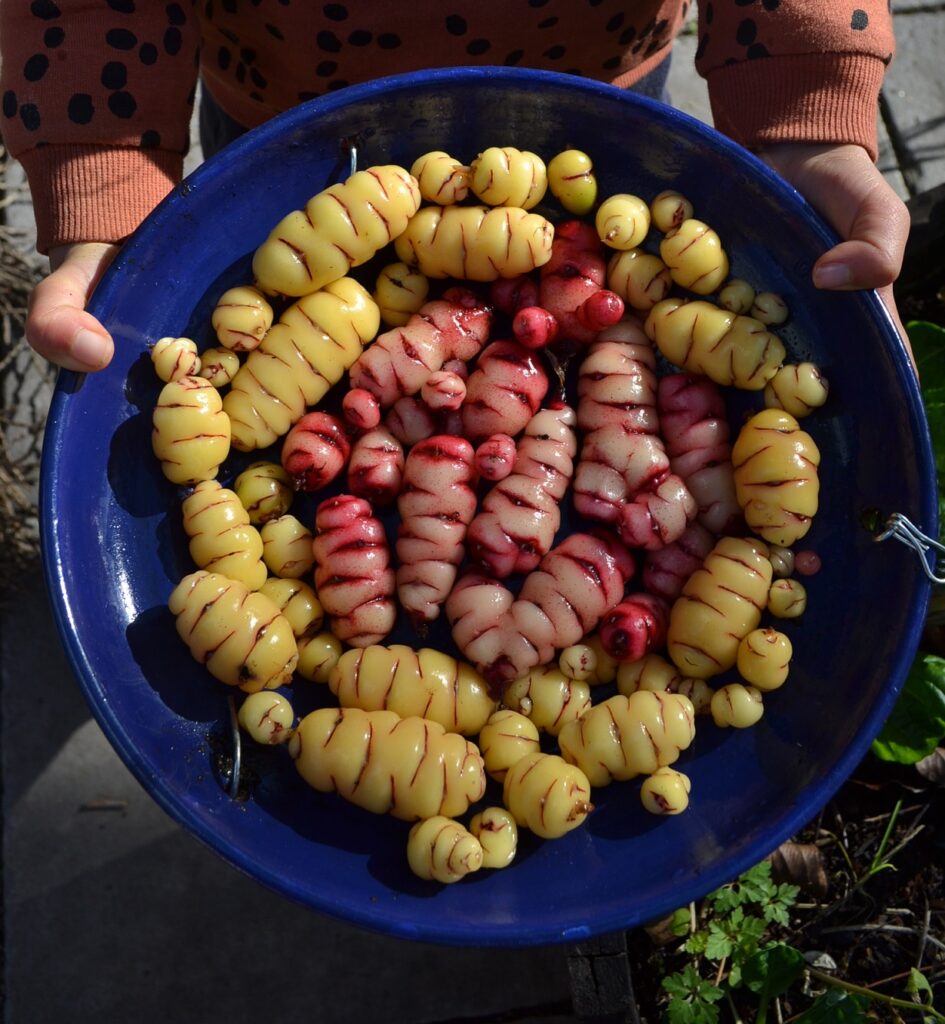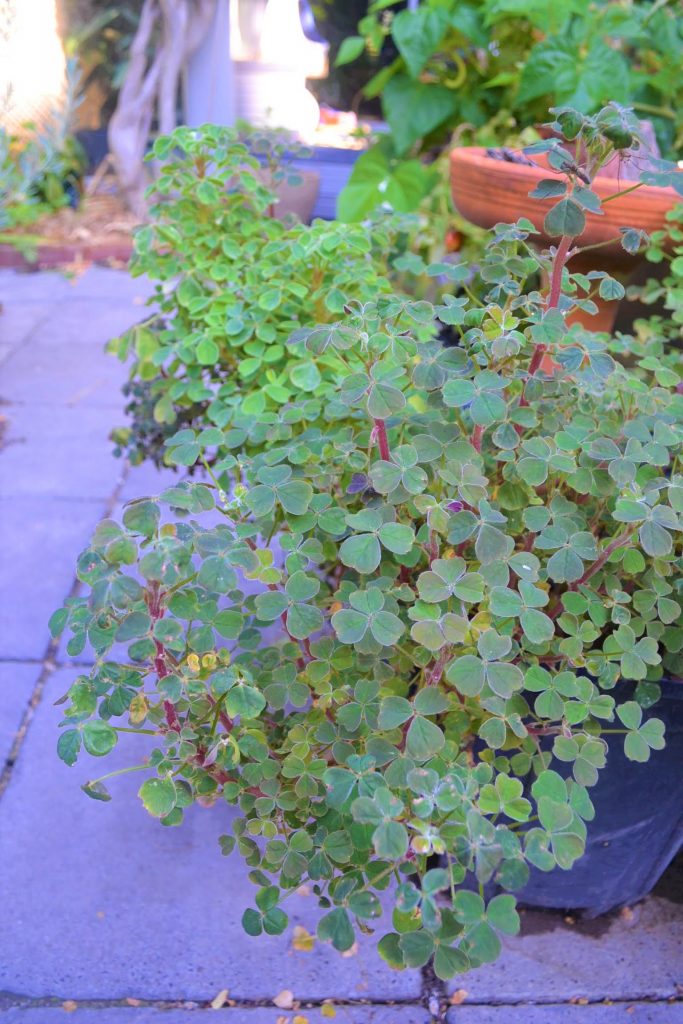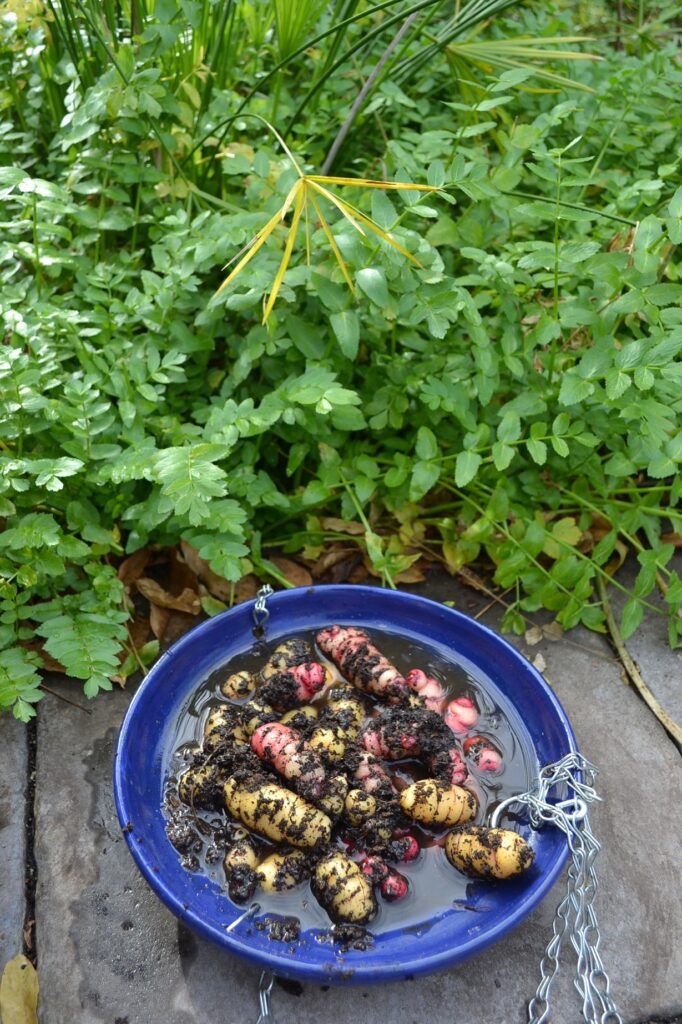Oca is a root vegetable you may not have heard of. It is a hardy, nutritious and tasty tuber – a great substitute for potato! Check out our article and Youtube video below for a detailed guide on how to grow and harvest, featuring a taste test from our harshest critics!

What is it?
Oca is one of those awesome heirloom veggies you may not have heard of – particularly since potatoes have become the commercialised staple. It is an ancient root vegetable, originating from the Andes, South America. It has been a treasured source of food for thousands of years.
Oca is also widely grown in New Zealand, hence its other common name, New Zealand yam. Although it is not from New Zealand, nor a yam! Common plant names can be curious things, and reflect more about a plant’s popularity in certain countries, than their true origins.
Oca looks a little bit like a kipfler (finger) potato, and also a little like a giant grub you might find in the soil. Oca comes in many different colours, from creamy white with red stripes, to rose red and bright pink.
Why should I grow it?

Oca is hardy – It is related to the weed oxalis. Being related to a weed speaks volumes about its toughness – it is tolerant of poor sandy soils and drought. I find it much easier to grow than potato, which needs rich soils and lots of water in order to produce well. But don’t worry – unlike its relative oxalis, it is not invasive!
Oca is highly productive – just a few tubers grown in a large pot will produce an abundance of tubers in one season.
It is far more nutritious than potato. Oca has a low Glycaemic Index and comes in many pretty colours from white creamy with red stripes, to bright pink and purple – they look like little gems.
Oca can be grown in part-shade, which makes it an incredibly valuable addition to a backyard food forest. It can be grown in the lower canopy as a living mulch.
Where do I get some?
While Oca is simple to grow, the hardest part can be getting your hands on some tubers to get started. This is because oca is mostly a backyard vegetable, grown and shared amongst gardeners and hasn’t been widely commercialised.
Oca holds up well in post so check out mail order garden suppliers for tubers. We will also have some for sale in our Shop in Autumn.
What does it taste like?
- Check out our Youtube video above for a frank taste test from the harshest critics! We compare both raw and cooked oca.
- Oca can be eaten raw or cooked, unlike potato which can only be eaten after cooking.
- Oca tastes quite similar to potato but a little more nutty and some say lemony. It can be steamed and mashed, baked or fried just like potato. You can also add it to soups or grate it raw in salads.
- Our favourite way to eat it is roasted with oilve oil and garlic, or julienned and stir fried with garlic, chilli pepper, lemon and coriander or parsley.
- Don’t throw out the leaves – they are also edible and add a lemony tang to salads. The leaves contain oxalic acid so eat in moderation for those who are intolerant to it.
Growing and harvesting tips
Planting time: Oca is a warm season vegetable so should be planted in late winter or early spring. Oca grows extremely well in Melbourne with minimal effort.
- In the tropics, plant somewhere shady under the canopy of other plants, but an area with good drainage. Oca doesn’t like it too hot or the foliage wilts. I would recommend planting it in a pot under the canopy of banana plants – this will provide it with a gentle microclimate.
- In particularly cold climates with short summers and harsh winters, you may need to plant it in a pot undercover.
Preferred soil: rich in compost but not too rich in manures and nitrogen. As with any root vegetable, fertilisers high in nitrogen will promote leafy growth over tuber growth, so best to minimise. Oca needs a well-draining soil, so if you have heavy clay soils best to plant in large pots or grow bags.
How to plant: Tuck a few tubers under the soil into a large pot (around 30cm diameter or larger), grow bag or in a garden bed. Top up with compost during the growing season, as more tubers will form wherever the stems touch the soil.
TIP! Remember to label straight away. As the leaves look a lot like oxalis the weed you don’t want family members accidentally pulling it out thinking it’s a weed.
Pests: Oca is a low-fuss low-maintenance vegetable, and largely disease free. It is attractive to rats and one year hungry rats ate a lot of our tubers so protect from rodents.
Harvesting: Only harvest when all of the foliage has yellowed, as this allows the plant to put all its energy into making big plump juicy tubers for you. In the Southern hemisphere, this generally occurs around the shortest day of the year in winter. Dig around carefully with your hands to unearth the brightly coloured tubers. Wash, clean and dry in the sun. Cure in the sun for up to a week for sweeter tubers. Then store away somewhere airy and dry, in the pantry or in a shed.
Save your best tubers: Oca can be treated like a perennial in the same way as potato – keep your best tubers to plant again in late winter to spring. You will be able to enjoy the taste of oca for many years to come!

Hi Jian,
You have a great site showcasing some amazing garden design layout and a successful way to grow good food. Well done.
Im also building a food forest, very rewarding.
I am interested to try the Oca tuber that you discuss on your blog.
If any tubers become available, please let me know.
Thank you
Romano
I bought some Oca from you last year. Harvested some really yummy tuber in July. It seems like the yellow Oca did not produced as much as the purple one. Would it be possible to leave the small tuber in the pot throughout winter?
Would like to purchase some more seedling of yellow Oca, could you please let me know when they will be available again?
Thank you very much
Shirley from Epping